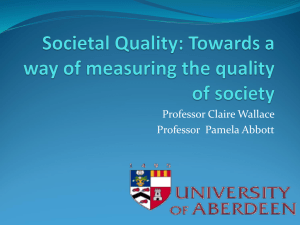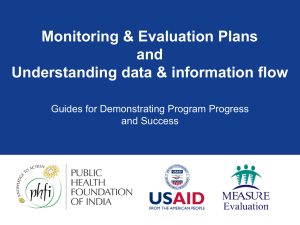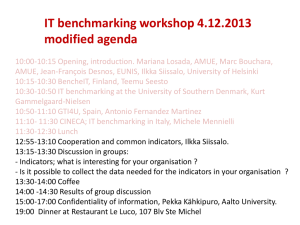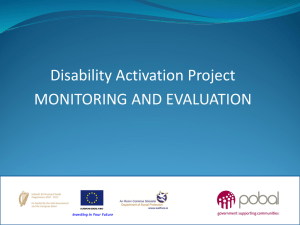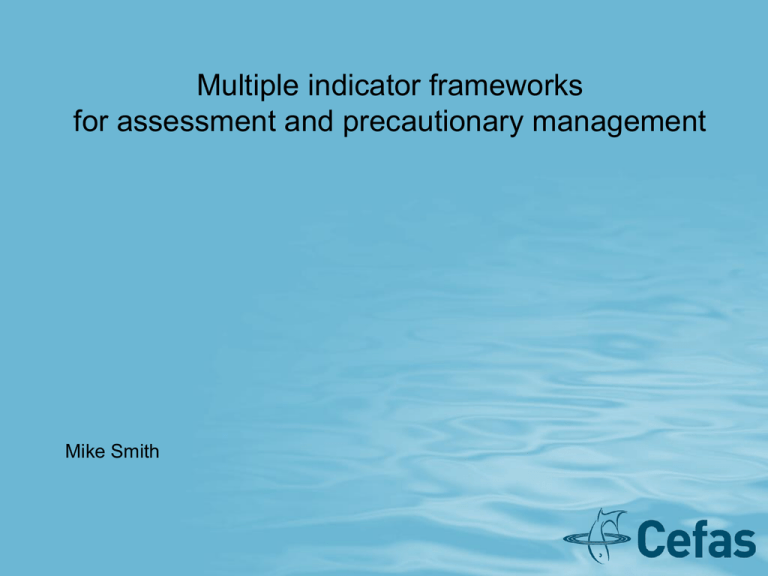
Multiple indicator frameworks
for assessment and precautionary management
Mike Smith
Precautionary approach
Implies that: a lack of full scientific certainty must not be used as a reason for
postponing cost effective measures to prevent environmental degradation”
(Principle 15, Rio de Janeiro Declaration; FAO, 1995)
The PA requires the following tasks to be accomplished:
Establishment of management objectives
Specification of information required
Assessment of the state of the stock, putting in evidence sources of uncertainty
Definition of the rules for management decisions, which should be robust to
uncertainty and incomplete knowledge on factors such as stock identity and
dynamics and the effects of environment (FAO, 1995).
Multiple indicator approaches (including TL systems) can provide a means of
incorporating the above features for systems where data do not permit more
sophisticated analytical stock assessments in support of management rules.
Multiple indicator frameworks
Enable the synthesis of signals from a range of sometimes empirical indices and
indicators by converting them into qualitative (or very simple scaled) terms (e.g.
good, moderate, bad), such that they can then all be considered on the same scale.
A framework to assemble, consider and combine data
consisting of (time series of) indices or indicators
that can inform on stock and fishery health (and potential) and
provide a means for assessment and informing management
They utilise relatively simple scoring systems, applied to each indicator to provide
indications of stock and fishery health.
Such scoring systems might include distributional thresholds (e.g. quantiles) and
approaches such as fuzzy set theory/logic can be used (e.g. to soften knife edged
thresholds).
Scoring of individual indicator/indices or of compound signals may be conditional on
the score or trend of another indicator/index.
The choice of which indicators/indices to use and/or the weighting of their scores into
compound signals is crucial to the overall outcome and could introduce subjectivity.
Indicators
Indicators are defined as variables, pointers or indices of a phenomenon (Garcia
et al. 2000).
They can support the decision making process by:
(i) describing the pressures affecting the ecosystem, the state of the ecosystem
and the response of managers,
(ii) tracking progress towards meeting management objectives
(iii) communicating trends in complex impacts and management processes to a
nonspecialist audience (Garcia et al. 2000; Rice 2000, 2003; Rochet and Trenkel
2003).
As attributes (of a pressure, state, response system ) may not be directly
measurable, indicators can act as proxies for them (Fulton et al. 2004a,b).
However, for indicators to support management decision making, the relationship
between the indicator current value and/or trend and the value and/or trend of the
variable (or indicator) associated with meeting the operational objective needs to
be known (Jennings, 2005).
Most research has focussed on indicators for state, however management usually
controls pressure and response describes the pressure and state changes (i.e.
feedback relationships).
Desirable properties for indicators (based on ICES 2005, and Rice and
Rochet, 2005)
Concrete: directly observable and measurable rather than abstract or only
estimated indirectly
Theoretical based: reflect features of ecosystems and human impact relevant to
objectives and be based on well-defined and validated theoretical links
Consistently understood: public understanding and technical meaning should be
consistent
Cost: cost-effective given limited monitoring resources
Measurable: measurable using existing instruments, monitoring programmes and
analytical tools, available on spatial and temporal scales needed for management,
have minimum or known bias and the signal should be distinguishable from noise
Context: supported by existing or time-series of data to aid interpretation of
trends and to allow a realistic setting of objectives
Sensitive: sensitive to changes in the state, pressure or response it is intended to
measure
Responsive: provide rapid and reliable feedback on the consequences of
management actions
Specific: respond to the properties intended to be measured rather than to other
factors and/or it should be possible to disentangle the other effects from the
observed response
Structure of multiple indicator frameworks
Typically, potential indices are grouped into 3 or 4 categories representing:
Abundance
Early season catch rate, survey counts, commercial fishing area, industry
perspective
Production
Number of recruits, mean size, average maximum size, sex ratio in catches,
proportion berried, density of larvae, condition factors, disease
Fishing pressure
Proportion immature in catch, total trap hauls (per area ground), incidental
mortality (discards or other gears), landings alternative species, exploitation rate,
total mortality, proportion females in catch, proportion of catch taken during
ovigerous period
Ecosystem and environment - harvest control rules for fish, have tended to
focus on indicators monitoring (spawning) biomass, recruitment and fishing
mortality, although environmental linkages are often more predictive for many
invertebrates (Caddy, 2004)
Predator abundance, prey abundance, temperature indices, wind/current flows
Reference points
Reference points that might support management decision making include:
(i) reference points for no impact,
(ii) limit reference points for the values of indicators associated with serious or
irreversible harm
(iii) target reference points for preferred values of the indicators
As indicator values include error, precautionary reference points may be needed
to guarantee a high (preferably specified) probability of avoiding a limit.
When indicators are used to guide management of target stocks, there is
a tradition of setting reference points (FAO 1998). In other fields, reference points
may not be specified and trajectories or directions may be used to guide decision
making.
Cliff edge
<- not that way or that way ->(but I’m not sure how far!)
Reference directions can guide management when the value of an indicator is
unsatisfactory or close to a limit, but when a target has not or cannot be defined
(Link, 2002; Trenkel and Rochet 2003; Jennings and Dulvy 2005).
unexploited
Increasing fishing impact
target
precautionary
limit
An example (for shrimp, Koeller et al, 2002)
Each indicator is considered under in methods, results (and brief interpretation)
sections. Additional supporting information can also be presented.
Traffic light colours were determined by pre-defined limits for individual indicators,
with default transition boundaries of the 33 and 67 percentiles.
In two cases (commercial CPUE)
polarity was considered to have
switched when considered with
other indicators (increased
aggregation & decreased survey
abundance), but the TL system did
not implement this.
An example (for shrimp, Koeller et al, 2002)
Halliday et al. (2001) proposed that decision rules should be based on an integrated
score of indicators measuring at least three characteristics: abundance,
production, and fishing mortality. If the proportion of indicators triggered within a
management rule determines the severity of management response some
redundancy and “smoothing” should be introduced because not all individual
indicators are likely to trigger simultaneously (Caddy 1999a, 1999b).
In this example, the aggregate
signals for abundance were
green in recent years, while the
production and fishing mortality
signals were declining to red in
2001.
This example was used for
assessment and information
only. Management rules were
based on separate simulation
modelling.
An example using fuzzy logic for an HCR (Murta & Silvert, 2002)
Using a knife edged threshold can lead to ‘flip-flop’ which should be avoided
(Rice,2003).
For example: If Biomass < Threshold the TAC=0 and If Biomass > Threshold the
TAC=0.4 * Biomass
Now if biomass is at the threshold it is 50%
high and 50% low and the TAC would be
obtained by averaging, i.e.
Low biomass High biomass
0.5 * 0
+
TAC
0.5 * 0.4 = 0.2*B = 250t
Grade of membership
Fuzzy set theory can be used to allocate biomass as high or low (above or below
a threshold). For example if a threshold were 500t, then below 250t could be
considered 0% high biomass and above 750t 100% high biomass, with
membership between interpolated. Stochastic output could also be used.
1.10
0.90
0.70
0.50
0.30
0.10
-0.10
200
400
600
800
Biom ass (t)
Fuzzy sets could also be used to define TAC and a range of indicators of fishery
performance resulting in control rules of the form
If Biomass is HIGH and Sampling is GOOD and Assessment model is GOOD and
… Then TAC will be LARGE
The membership of TAC is then ‘defuzzified’ to give a crisp value for the TAC
References
Caddy, J.F., 1999a. Deciding on precautionary management measures for a stock
based on a suite of limit reference points (LRPs) as a basis for a multi-LRP harvest
law. NAFO Sci. Counc. Stud. 32: 55–68.
Caddy, J.F., 1999b. A short review of precautionary reference points and some
proposals for their use in data-poor situations. FAO Fish. Tech. Pap. No. 379.
Caddy, J.F., 2004. Current usage of fisheries indicators and reference points, and
their potential application to management of fisheries for marine invertebrates. J.
Fish. Aquat. Sci. 61: 1307–1324.
FAO, 1995. FAO, 1995. Precautionary approach to fisheries. Part I: Guidelines on
the precautionary approach to capture fisheries and species introductions. FAO
Fish. Tech. Pap. 350(1), FAO, Rome, 52 pp. Reproduced with minor editing as FAO
Technical Guidelines for Responsible Fisheries. No. 2.
FAO, 1998. A short review of precautionary reference points and some proposals for
their use in data-poor situations. FAO Fisheries Technical Paper No. 379, 30 pp.
Fulton, E.A., Smith, A.D.M., Webb, H. and Slater, J., 2004a. Ecological indicators for
the impacts of fishing on non-target species, communities and ecosystems:
review of potential indicators. Australian Fisheries Management Authority Final
Research Report No. R99/1546, 116 pp.
References
Fulton, E.A., Fuller, M., Smith, A.D.M. and Punt, A., 2004b. Ecological indicators of
the ecosystem effects of fishing: final report. Australian Fisheries Management
Authority Final Research Report No. R99/1546, 239 pp.
Garcia, S.M., Staples, D.J. and Chesson, J., 2000. The FAO guidelines for the
development and use of indicators of sustainable development of marine capture
fisheries and an Australian example of their application. Ocean and Coastal
Management 43, 537–556.
Halliday, R.G., Fanning, L.P., and Mohn, R.K. 2001. Use of the traffic light method
in fishery management planning. Can. Sci. Advisory Secretariat Res. Doc. No.
2001/108.
ICES (2005) Guidance on the application of the ecosystem approach to
management of human activities in the European marine environment. ICES Cooperative Research Report No. 273, 22 pp.
Jennings S., 2005, Indicators to support an ecosystem approach to fisheries. Fish
Fish. 6, 212–232.
Jennings, S. and Dulvy, N.K. (2005) Reference points and reference directions for
size-based indicators of community structure. ICES Journal of Marine Science 62,
397– 404.
References
Koeller, P.A., Cover, M. & King, M., 2002. A new traffic light assessment for the
Eastern Scotian Shelf Shrimp Fishery in 2001. Canadian Science Advisory
Secretariat, 2002. 50pp.
Link, J.S. (2002) Ecological considerations in fisheries management: when does it
matter? Fisheries 27, 10–17.
Murta, A.G. & Silvert, W., 2002. A framework to put in practice a precautionary
approach to fisheries assessment based on fuzzy set theory. ICES CM
2002/ACFM:10. WD.
Rice, J.C. (2000) Evaluating fishery impacts using metrics of community structure.
ICES Journal of Marine Science 57, 682–688.
Rice, J.C. (2003) Environmental health indicators. Ocean and Coastal Management
46, 235–259.
Rice, J.C. and Rochet, M.-J. (2005) A framework for selecting a suite of indicators
for fisheries management. ICES Journal of Marine Science 62, 516–527.
References
Rochet, M.-J. and Trenkel, V.M. (2003) Which community indicators can measure
the impact of fishing? a review and proposals. Canadian Journal of Fisheries and
Aquatic Science 60, 86–99.
Trenkel, V.M. and Rochet, M.-J. (2003) Performance of indicators derived from
abundance estimates for detecting the impact of fishing on a fish community.
Canadian Journal of Fisheries and Aquatic Science 60, 67–85.






